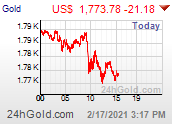GOLD STARTS AND ENDS WEEK WELL:After last week’s dip in the Gold market, Monday showed Gold starting December strong on positive manufacturing news from China, regaining some of the footing lost in November. The data from a private manufacturing purchasing-managers index came in slightly stronger than anticipated. In addition, Gold could stabilize after last week’s sell off. A strategist at Credit Suisse wrote in a research note that the sell off “appears absorbed and we think prices should now stabilize before a modest recovery could take place towards the end of the year. The seasonal weakness of the U.S. dollar in December should also help.” Just as the week before, the market was in for a ride. Tuesday’s Gold market ended at its lowest point since November 4, dropping more than one percent of its total value. There have been multiple factors that contributed to the move, such as the United States’ inability to deal with the budget crisis and the major sell-off of Gold by investors in the past week. However, some believe this has been in the making for much longer. “You cannot attribute this kind of volatility to any sudden, new fundamentals. There are obviously some large fund-algorithmic-type players moving the market around,” Bill O'Neill, partner at commodities investment firm LOGIC Advisors, said. In the days following the dip, prices started to rise. Bargain hunters who have purchased on the recent dips along with meager economic forecasts by the European Central Bank (ECB) are the cause of the modest rebound. After losing 1.6 percent over the past two days, many Gold investors await U.S. nonfarms payroll data to be released Friday, as well as reports from next week’s Federal Reserve meeting. “We have the ECB decision today, with some (talk) of Spain applying now for financial help, and furthermore we have the Fed decision,” LGT Capital analyst Bayram Dincer said. “Also, some people are positioning for year-end profit taking. All of this is adding to negative sentiment in the Gold market.” By the end of another up and down week, Gold has recouped some but not all of its losses, ending the week lower overall.
EUROPE STAYS THE COURSE:
The economic news in Europe seems to be on repeat from week to week. There have been reports of good, bad and indifferent. The good this week belongs to the Greeks. The announcement of the terms of the Greek debt buyback program was a boost to the economic troubles of the country.The economic issues in Greece have been well documented and many believed it was a lost cause.However, Greece announced they would be spending more than market experts previously expected. “The market is taking a fairly optimistic view that we will see a smooth implementation of these (Greek) plans,” said Ian Stannard, head of European FX strategy at Morgan Stanley in London. On the bad side of the news, there is Spain. The euro had a big upswing yesterday due to positive news out of Greece, but some of those gains have been taken back due to negative news out of Spain. The euro had reached a seven week high yesterday however, due to current economic issues in the area, it was not expected to last. Camilla Sutton, chief currency strategist at Scotia Capital in Toronto, said, “There is still too much uncertainty to drive euro back to its year-to-date highs (near) $1.35 accordingly we would expect the current rally to top out.” The ECB had a meeting this week to discuss future plans, which could include the possibility of further monetary easing. When you combine the good and the bad it brings the picture into focus. The ECB held interest rates to a record low of 0.75 percent Thursday. This move hinted at the possibility of cuts next year. Recent policymakers’ comments have suggested that rate cuts are not likely in the near future however, some have speculated that cuts might happen in March. Basically, the theme continues to be holding the course and hoping for the best.
UNITED STATES’ BIG REPORTING SURPRISE:
The fiscal cliff continues to get closer every day and there does not seem to be any major progress to report on. On the other hand, there was much to discuss in the way of job reports this week. The ADP jobs report, which shows new jobs added in the private sector, showed a gain of 118,000 jobsin November, which is mostly in line with economists’ projections. Many investors kept an eye out for Friday’s nonfarms payroll report for more news on the job market. Economists expected those numbers to gain, but not enough to lower the unemployment rate below 7.9 percent. If one thing has been shown throughout time is to expect the unexpected. All eyes were on the jobs report this morning, with expectations of just 80,000 to 93,000 jobs added in November. When the report came out, it showed that 146,000 jobs had been added and the unemployment rate dropped .2 percent down to 7.7 percent. Hurricane Sandy was expected to have more of a negative impact on the report, but the Labor Department said that next month’s report could show its effects more accurately. Sometimes even the “experts” get it wrong.










